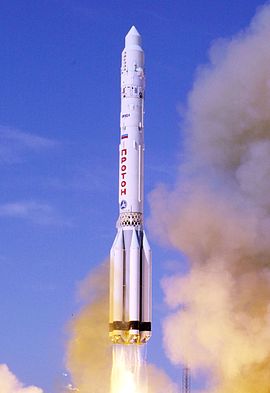Proton (rocket)

Launch of a Proton-K rocket
|
|
| Function | Orbital launch vehicle |
|---|---|
| Manufacturer | Khrunichev State Research and Production Space Center |
| Country of origin | Soviet Union; Russia |
| Size | |
| Height | 53 metres (174 ft) |
| Diameter | 7.4 metres (24 ft) |
| Mass | 693.81 metric tons (1,529,600 lb) (3 stage) |
| Stages | 3 or 4 |
| Capacity | |
| Payload to LEO | 22.8 metric tons (50,000 lb) |
| Payload to GTO |
6.3 metric tons (14,000 lb) |
| Launch history | |
| Status | Grounded |
| Launch sites | Baikonur, LC-200 & LC-81 |
| Total launches | 412 (9 June 2016) |
| Successes | 365 |
| Failures | 47 |
| First flight |
Proton: 16 July 1965 Proton-K: 10 March 1967 Proton-M: 7 April 2001 |
| Last flight |
Proton: 6 July 1966 Proton-K: 30 March 2012 |
| Notable payloads |
Salyut 6 & Salyut 7 Mir & ISS components ViaSat-1 |
| First stage | |
| Engines | 6 RD-275 |
| Thrust | 10.47 MN (1.9 million pounds) |
| Burn time | 126 s |
| Fuel | N2O4/UDMH |
| Second stage | |
| Engines | 3 RD-0210 & 1 RD-0211 |
| Thrust | 2.399 MN (539,000 lbf) |
| Specific impulse | 327 s |
| Burn time | 208 s |
| Fuel | N2O4/UDMH |
| Third stage | |
| Engines | 1 RD-0212 |
| Thrust | 630 kN (140,000 lbf) |
| Specific impulse | 325 s |
| Burn time | 238 s |
| Fuel | N2O4/UDMH |
| Fourth stage - Blok-D/DM | |
| Engines | RD-58M |
| Thrust | 83.4 kN (18,700 lbf) |
| Specific impulse | 349 s |
| Burn time | 770 s |
| Fuel | LOX/RP-1 |
Proton (Russian: Протон) (formal designation: UR-500) is an expendable launch system used for both commercial and Russian government space launches. The first Proton rocket was launched in 1965. Modern versions of the launch system are still in use as of 2016, making it one of the most successful heavy boosters in the history of spaceflight. All Protons are built at the Khrunichev State Research and Production Space Center plant in Moscow, transported to the Baikonur Cosmodrome, brought to the launch pad horizontally, and raised into vertical position for launch.
As with many Soviet rockets, the names of recurring payloads became associated with the Proton. The moniker "Proton" originates from a series of similarly named scientific satellites, which were among the rocket's first payloads. During the Cold War, it was designated the D-1/D-1e or SL-12/SL-13 by Western intelligence agencies.
Launch capacity to low Earth orbit is about 22.8 tonnes (50,000 lb). Geostationary transfer capacity is about 6.3 tonnes (14,000 lb).Commercial launches are marketed by International Launch Services (ILS). The rocket is intended to be retired before 2030.
In January 2017, the Proton was temporarily grounded due to the manufacturer, Voronezh Mechanical Plant, having substituted a heat-resistant alloy in the engines with a cheaper metal.
Proton initially started its life as a "super heavy ICBM." It was designed to launch a 100-megaton (or larger) thermonuclear weapon over a distance of 13,000 km. It was hugely oversized for an ICBM, and was never deployed in such a capacity. It was eventually used as a space launch vehicle. It was the brainchild of Vladimir Chelomei's design bureau as a foil to Sergei Korolev's N1 rocket whose purpose was to send a two-man Zond spacecraft around the Moon; Korolev openly opposed Proton and Chelomei's other designs for their use of toxic propellants.
...
Wikipedia
